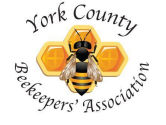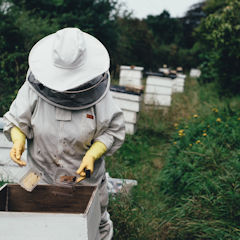Swarm Facts
As the days get longer and the temperatures get warmer, honey bee activities begin to increase as they prepare for the spring nectar flows. The bees are now beginning to build up their populations in order to have enough worker bees to gather the nectar. As the populations build up, some bee colonies increase their numbers very quickly and some individual hives may become overcrowded. These overcrowded conditions can stimulate a phenomenon called "swarming".
Swarming is part of the reproductive cycle in honey bees. Though honey bees reproduce individual bees through mating and egg-laying, swarming is how honey bees create new colonies. The process of swarming involves production of a new queen within an individual colony. When this queen emerges and is ready to take on the duties of a queen bee, the old queen (the new queen is now the queen of the old hive), along with approximately one-half of the workers in that colony, will leave the hive as a large mass of bees. This mass of bees will congregate on a tree limb, fence post or on a side of a building near the original hive. A congregation of bees in this manner is called a swarm. (Some colonies will swarm several times, so some of these swarms will have new queens.)
While the bees are in this swarm, some workers are sent out to search for a suitable place to start a new hive. We call these particular workers "scouts". When some of the scouts have found a favorable site for a new hive (such as a hollow tree), they report back to the swarm and then the swarm leaves the swarming site to go to the new hive.
Swarming season, in York County, can begin in April and can last through the first of July. Some of you may have the opportunity to find a swarm this spring. You may find a clump of bees that can range from about the size of a softball to as large or larger than a basketball. You may find them on a tree limb, in a shrub, on a fence post or on the side of a building. If you find a swarm, the best thing that you can do is leave it alone. Honey bees, that are in a swarm, are not aggressive because they have no hive to defend at this time. These bees, however, should only be handled by an experienced beekeeper.
Swarms may stay on a swarming site for as little as 15 minutes or for several days or more. It depends on the length of time it takes for the scouts to find a new hive. So when you see a swarm, keep in mind that they will not be on that site permanently.
Spraying honey bee swarms with insecticide is not recommended for several reasons. First of all, even though the bees are not aggressive during swarming, you run the risk of getting stung if you try to spray them. Secondly, the bees are only going to be there for a short period of time, so spraying them will be a waste of your time. Finally, if the swarm is reachable, the bees are valuable to a beekeeper. If a swarm is found before it locates a new home, a beekeeper can capture the swarm and start a new hive with the bees.


